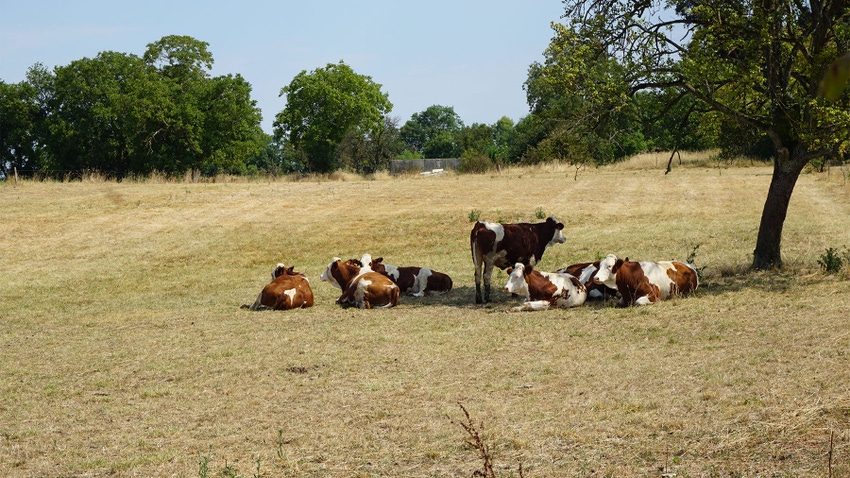September 13, 2023

The 2023 drought brought challenges to farms across Missouri, but help is available.
The Soil and Water Conservation District offers assistance mainly in the form of variances to existing practices. They were approved at the Soil and Water Districts Commission.
The University of Missouri Extension gathered the following information from Executive Order 23-05, which is effective until it expires Dec. 1, unless terminated or extended by subsequent order.
The variances approved apply to districts that reach a minimum of D2 (severe drought) status and higher. Once any portion of a county has reached D2 status, the variances are available throughout the county. The county will remain eligible for the variances until the executive order expires, even if the level of drought is reduced below D2.
The Soil and Water Conservation Districts are offering several drought assistance practices. The first one below is a reinstatement of a practice, and the rest are variances to continual offerings:
Help with pond cleanout. The DWC-02 Water Impoundment Reservoir Cleanout Practice is only available in D2 or higher drought-designated counties. It can only be used for ponds constructed with state cost share. The maximum for the cleanout part of the practice is $6,000 — fence and water supply components are available as needed and do not fall under the $6,000 limit.
Cost share is authorized for:
Complete removal of sediment in the pool area on DWC-1 Water Impoundment Reservoir that will be used for livestock water.
Installation of a limited access point or a permanent siphon pipeline installed around the dam and a tank for livestock watering, if a watering facility is not already available on the structure.
Tank only if a water supply line is already installed.
Exclusion fence to protect from livestock if the structure previously was not fenced or the fence has deteriorated to where it will no longer exclude cattle. Grazing is not allowed at any time in the excluded area.
Critical area seeding for the spoil and areas above the normal pool elevation that was disturbed during the cleanout.
Grazing practices. This variance defers the grazing school requirement for 12 months after contract payment or the Water Development (DSP 3.1) and Water Distribution (DSP 3.2) Grazing System practices. The contracts will be for only one watering tank and pipeline and water source development. The rest of the system can be designed and installed after the landowner has completed an approved grazing school. It is important that producers understand managed grazing before designing their systems. A landowner may use this variance on two grazing systems that are not contiguous.
A landowner who has already attended a grazing school and needs assistance with water is not limited to one tank.
Cover crop practices. The lifetime maximum and haying variance allows cover crops to be harvested for livestock feed at termination to provide additional forages and waives the two-production crop rotation requirement for the next planted production crop.
In addition, there is a temporary removal of the N340 Cover Crop Practice maximum for the operators planning to harvest the forage for feed, which would allow assistance to anyone who has reached the $20,000 lifetime maximum. Landowners over the $20,000 maximum will receive $30 per acre for any additional acres enrolled.
To exceed the $20,000 lifetime maximum, the landowner or operator must be intending to harvest the additional acreage in cover crop for livestock feed. Any contracts approved before the executive order expiring is eligible for harvesting the cover crops for feed any time.
Livestock exclusion requirements. This allows immediate grazing in any of the livestock exclusion areas such as the DFR-5 Woodland Protection Through Livestock Exclusion, DWC-1 Water l Impoundment Reservoir, N386 Field Border, N393 Filter Strip, N472 Livestock Exclusion, and WQ10Stream Protection practices. Grazing is allowed provided the area is established in forage that can withstand grazing.
Reseeding stands. The variance allows districts to provide assistance to reseed a practice anytime during the maintenance life of the practice in which the grass stand failed because of the drought of 2022 or 2023. Additionally, if the landowner already received a payment for a reseeding of a practice following the policy, they are eligible for another payment for that practice if the seeding has failed again due to the drought. The variance applies to the following practices:
DSL-01 permanent vegetative cover establishment
DSL-02 permanent vegetative cover improvement
DSP-02 permanent vegetative cover enhancement
DSP-3.5 grazing system seed
Districts may handle implementation of these practices differently, so contact your local office for more specifics.
Source: University of Missouri Extension
Read more about:
DroughtYou May Also Like




